Different Varieties & Types of Jacaranda Tree Species
Among the true varieties & cultivars of Jacaranda, blue jacaranda trees are the most common to spot.
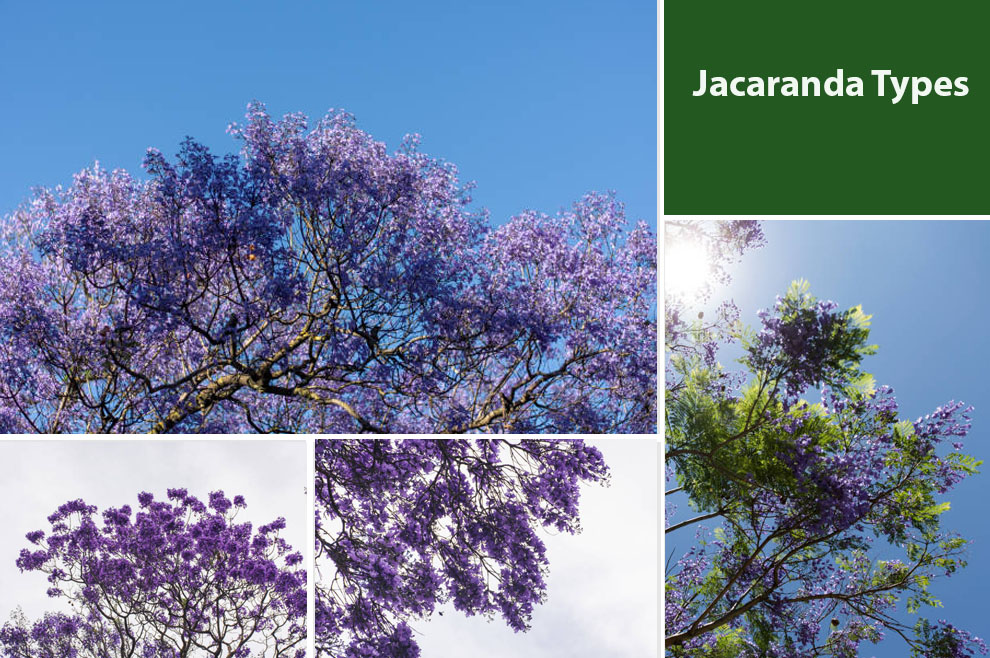
Botanically called the Jacaranda Mimosifolia, the Jacaranda tree is a gorgeous tropical tree. It yields scented purple flowers in bundles that are panicle-shaped. It is an ornamental tropical tree with arched branches that form a canopy that looks like an inverted umbrella. Its remarkable fern-like green colored leaves grow up to twenty-inches long.
The genus Jacaranda comprises around forty-nine different types of jacaranda trees’ species. The most popular ones include Jacaranda Mimosifolia blue jacaranda and Jacaranda Mimosifolia Alba. But, the name Jacardana is also applicable to several plants from the Pea family’s Machaerium genus, via which you acquire the commercial rosewoods.
Given its spreading stature, Jacaranda makes for a beautiful shade or street tree, prominent in gardens, parks, and roadside.
Native to Central and South America and equally popular in California and Florida, the Jacaranda tree is a fast-growing, typically in the tropical environment. It grows almost ten feet per year in the initial years.
However, the growth rate may vary between the various jacaranda types. Their geography also plays a role in it. So, if you plant it away from its native tropical environment, the growth rate might slow to moderate.
The jacaranda tree grows best between fall and early spring. They might be deciduous or semi-evergreen, depending on their geography. Only the mature trees, eight years or older, flower and bloom from late spring to early summer. However, in warmer regions, they may flower at different intervals.
Let us get started and address different kinds of Jacaranda trees.
Jacaranda Tree Overview
| Scientific name | Jacaranda Mimosifoila |
| Common name | Black poui, blue jacaranda |
| Hardiness Zone | 10 and 11 (USDA) |
| Family | Bignoniaceae |
| Native | South America |
| Bloom Time | Spring, summer |
| Bloom Color | Purple, blue-purple |
| Height | 25–50 ft. |
| Spread | 15–30 ft. |
| Lifespan | Typically, most types of jacaranda trees have a long lifespan. They live for five decades, but some can even live for up to two centuries. |
| Water | Water when the top three to four inches of soil feels dry to the touch. |
| Sun | Full sun |
| Soil Preference | Sandy well-drained soil with neutral to acidic pH. |
| Temperature | It can tolerate occasional cold weather days (as low as 20 degrees Fahrenheit), but generally, it does not thrive in climates with frequent freezing temperatures. |
Jacaranda Tree Varieties
- Jacaranda mimosifolia ‘Blue Jacaranda’
- Jacaranda Mimosifolia ‘Alba’ or ‘White Christmas’
- Jacaranda jasminoides ‘Maroon’
- Dwarf Jacaranda ‘Bonsai Blue’
- Jacaranda caerulea ‘Boxwood’
- Jacaranda cuspidifolia
- Tipu tree ‘Yellow Jacaranda’
Now, let us list down some prevalent varieties of this magnificent tree:
1. Jacaranda mimosifolia ‘Blue Jacaranda’
It is often called the tree with intense beauty. It has a huge crown that spreads across fifteen to thirty feet. This semi evergreen tree has upright branches and grows up to a height of twenty-five to thirty feet.
It is a beautiful specimen tree, made for medium to large spaces. Courtesy of its attractive dark green, pinnately compound leaves that form a canopy, this tree works as a great shade tree.
Popular in America, the tree thrives in the Southern states but is equally popular in Texas, Florida, and California. This flowering tree can convert any landscape into a beautiful sight, courtesy of its light purple, lilac, and blue hues.
Please remember it can be a little messy because of the flower drops.
2. Jacaranda Mimosifolia ‘Alba’ or ‘White Christmas’
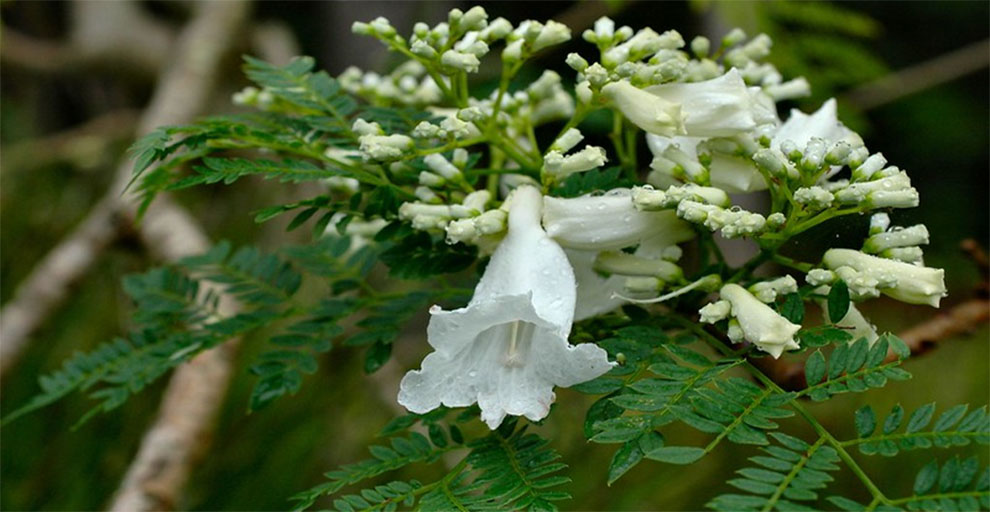
Popularly known as the Black Poui or the Fern Tree, White Christmas has attractive flowers that show around Christmas, as is apparent from its name.
These jacaranda tree varieties have fern-like, soft, and delicate deciduous foliage and dense terminal clusters of lightly fragrant, pure white, trumpet-shaped flowers, which add to the beauty of this vast, spreading tree.
Also popular as a specimen tree, its blooms show from April through August but might often be present before the new, fresh, light green leaves show in the spring. It flowers the best after a good winter with several nights in the upper thirty degrees.
It has an arching or bent trunk covered with light gray bark. Native to South-Central South America, this sub-tropical, fast-growing deciduous plant grows between 25 and 40 feet.
3. Jacaranda jasminoides ‘Maroon’
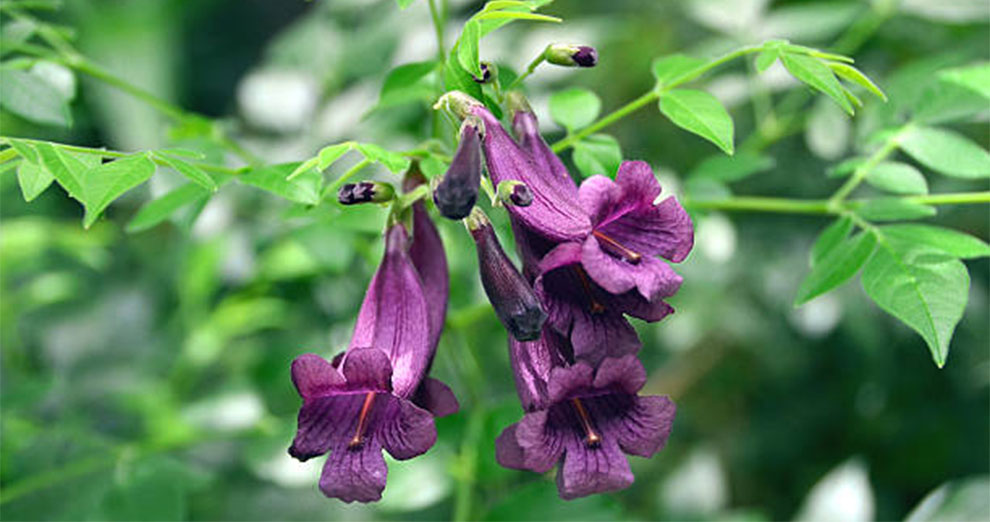
It is a dwarf cultivar that grows between 10 and 25 feet tall and produces maroon-purple flowers. It can grow as an evergreen or deciduous tree or a shrub. The plant can bloom while it is still small in a one to three-gallon pot and is a suitable pick for a patio or small garden.
You can grow it as a house plant in a greenhouse or near a bright window. The younger varieties are frost-sensitive (to 25 F, -3 C). So, you must take steps to guard them on cold winter nights. However, the adult trees are resistant to 20 F or -7C.
4. Dwarf Jacaranda ‘Bonsai Blue’
It is a dwarf, charming variety with showy flowers. The Dwarf Jacaranda Bonsai Blue can be a specimen of any small yard or garden. So, if you have a contemporary, tropical, or rustic landscape, this tree can be a beautiful inclusion. It can be a good pick and proves highly beneficial as a decorative tree in pots placed on the terrace or patio, where it creates a magnificent impact.
The plant has attractive fern-like, bright green foliage that adds a contrast to the perennial gardens. This semi-evergreen tree is drought-resistant and thrives best in the warmer regions between USDA hardiness zones nine through eleven.
These jacaranda tree varieties yield flowers from May to June, showcasing the beautiful blue flowers that can add vibrance to your patio or garden. It is a fast-growing plant that grows up to six feet tall and five feet wide.
Its beautiful blooms attract butterflies, bees, and other pollinating wildlife, making your yard or landscape more lively.
What’s more?
It is a low-maintenance, hassle-free tree that does well in enriched, well-draining soil, provided you plant it in a site where it receives full sun. The plant can also tolerate somewhat alkaline soils. Potted plants can thrive in a container about 18 inches in diameter.
5. Jacaranda caerulea ‘boxwood’
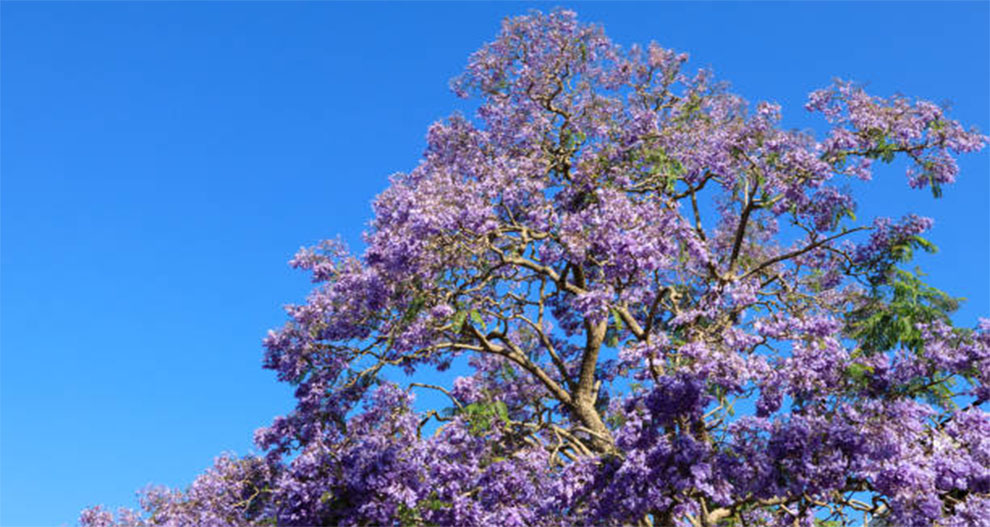
Described by the French naturalist Jean Henri Jaume Saint-Hilaire in 1805, the Jacaranda caerulea is a decently tall tree that grows up to thirty-nine feet or 12 meters. The plant has long, bipinnate leaves of about forty cm each with about eight to twenty-six pinna. It has a tabular shape and purplish-blue colors that are narrower around the base and bigger at the tip.
Each of its flowers is about 3.5 to 4 cm long and about 1 to 1.4 cm wide at the mouth. The plant flowers intermittently across summer and spring and do not have one significant bloom period during spring like other varieties.
Native to Cuba, Hispaniola, and the Bahamas, you can also spot these jacaranda types in Florida, where it became famous as a landscape tree. The tree is prevalent in limestone areas between sea level and 300 meters.
People use its leaves for their antiseptic properties. People in the Bahamas employ its dried leaves to make decoctions. It is also an alternative treatment for different skin complaints.
6. Jacaranda cuspidifolia
Commonly referred to as the Purple fern tree, Jacaranda Cuspidifolia is a beautiful flowering deciduous tree with a globose, wide crown. It can grow between five and ten meters tall, and its stem can be about thirty to forty cm in diameter. It is a rapidly growing plant with large canopies and frond-like, oppositely paired, compound-long leaves.
People usually plant these jacaranda tree species in areas where they need some shade. Even though Jacaranda Cuspidifolia is native to the Americas, you can find this tree cultivated around the world, wherein the climate is tropical or sub-tropical.
It is also hugely popular in warm regions around the world and the greenhouses for its violet or blue flowers. It is an attractive ornamental tree, especially in areas where it blooms beautifully. Some people harvest its wood from the wild for local use.
7. Tipu tree ‘Yellow Jacaranda’
It is an easy-growing, beautiful flowing tree with attractive yellow flowers that bloom in late summer. Its leaves are pinnately compound, composed of leaflets about one to three inches long. It is a prominent tree and grows up to fifty feet with an almost equal spread. The plant is widely famous as a butterfly-attractive shade tree.
Tipuana tipu is a cold hardy yellow Jacaranda with a varying growth rate that depends on the temperature, sunlight, soil type, and various other factors. You can grow them in the ground or the pot, and they add a showy accent to the patio, garden, or outdoor space.
It enjoys well-drained soil with a general potting mix available at a local box store. However, you must keep Tipu Trees away from wet, arid, and mucky soils. The plant thrives in USDA hardiness zones 9 A through 11 with 80 to 100 percent sun. Depending on your geography, the plant grows best in full sun.
Related: Jacaranda Tree Care Guide
More About Jacaranda Tree Flowers, Bark, Leaves, and Fruits
Let us discuss some common attributes you can expect in the Jacaranda species.
A. The Flowers
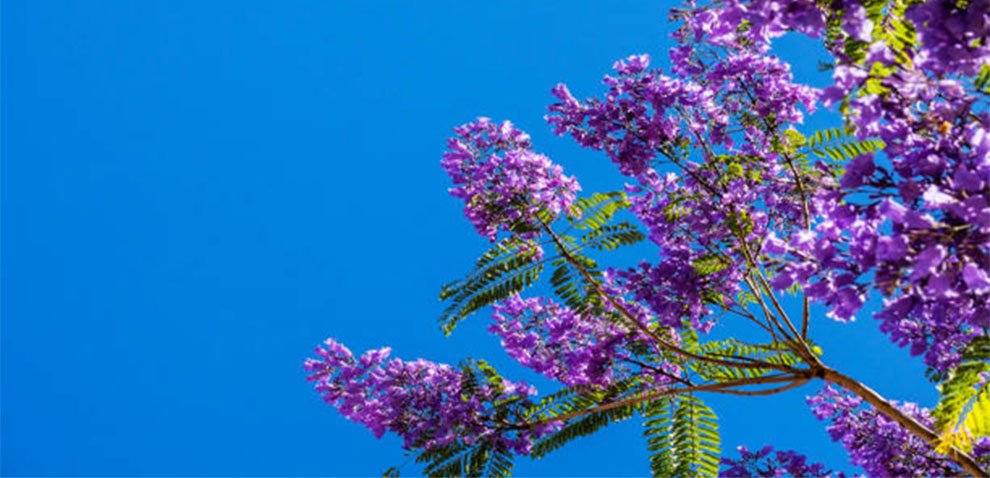
All types of jacaranda trees have trumpet-shaped flowers that typically grow in bunches. The individual flowers are about two inches long. Its lilac or blue panicles grow about twenty cm long. Typically, these flowers show in early summer and late spring and last for about two months.
Blue Jacaranda is one of the most popular type of jacaranda. People automatically think of blue flowers whenever there is a mention of Jacaranda.
Typically, Jacaranda yields flowers that are very pale blue but seem white. If grown in warm regions, jacarandas might bloom around the year in others colors as well.
Jacaranda Mimosifolia Alba is another popular variety. It is a tropical plant with white flowers. Sadly, the smaller varieties, or those that grow in containers or indoors, rarely bloom.
B. Jacaranda Tree Leaves
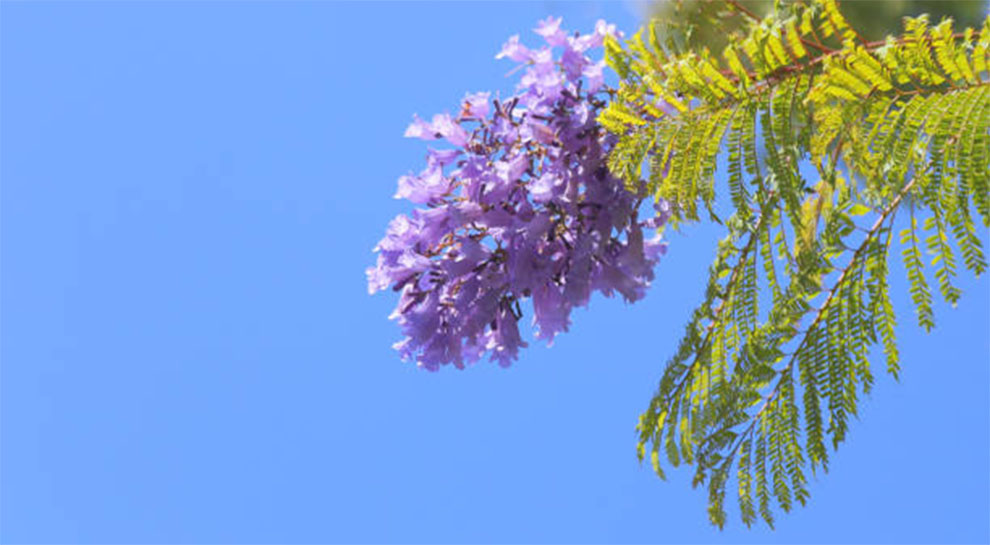
The plant has bi-pinnate, fern-like leaves. It implies that the leaves comprise leaflets around the midrib, and every significant one has several smaller leaflets. Every leaf reaches up to fifty cm and changes its color to brown in the autumn months.
C. Jacaranda Bark
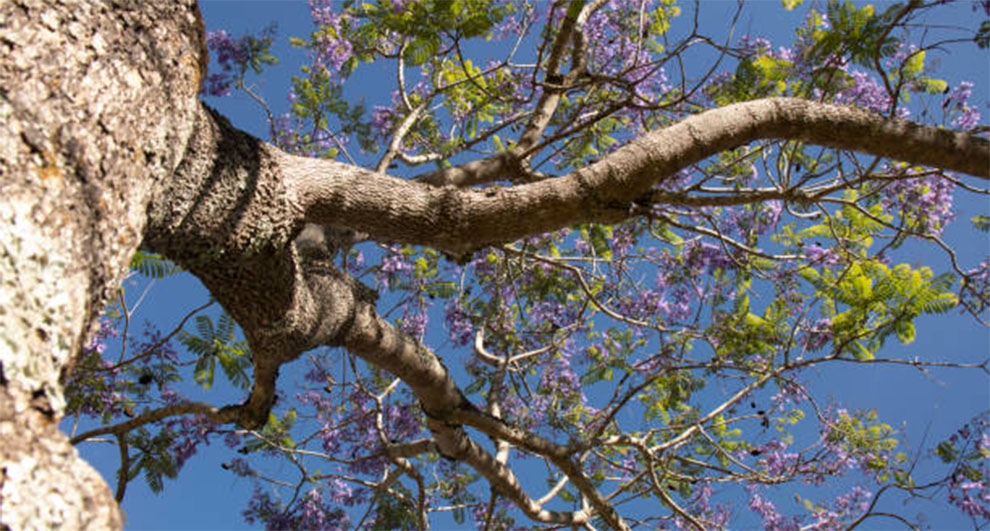
Most jacaranda types have a grayish-brown color and are typically delicate and thin when the tree is immature. Upon maturity, the bark takes up a scaly texture and appearance. Its twigs have a zig-zag shape and a curving appearance. If the bark changes its color, it might indicate a fungal infection.
D. Jacaranda Tree Fruit (Seed Pods)
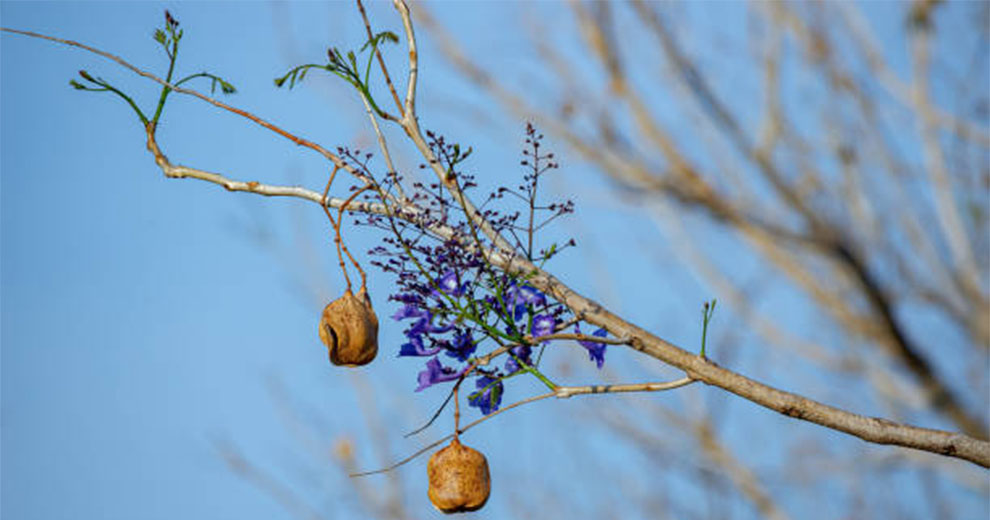
Jacaranda tree species produce fruits in the form of woody seedpods. They have a unique mahogany color and are used as decorative pieces. These seed pods are about 3 inches wide and appear in late summer. Once you open these pods, you can find the winged seeds covered in papery casings.
Frequently Asked Questions
Ques 1. Is a jacaranda tree invasive?
Ans. The Jacaranda trees are invasive in some areas as they out-compete several native plants. People in parts of Australia and South Africa refer to it as an invasive weed. Thus, you may need permission to plant it in your yard or garden.
Ques 2. Is jacaranda the same as wisteria?
Ans. Both Wisteria and Jacaranda are different. The former is a medium-sized tree, and many confuse it for Jacaranda because of its purple pea flowers that somewhat look like the Jacaranda tree.
Ques 3. Where should you not plant a jacaranda tree?
Ans. All the different types of jacaranda trees have a vigorous root system. Hence, one must never plant Jacaranda trees near swimming pools, water lines, paths, house foundations, and drains as they can cause damage to these structures.
